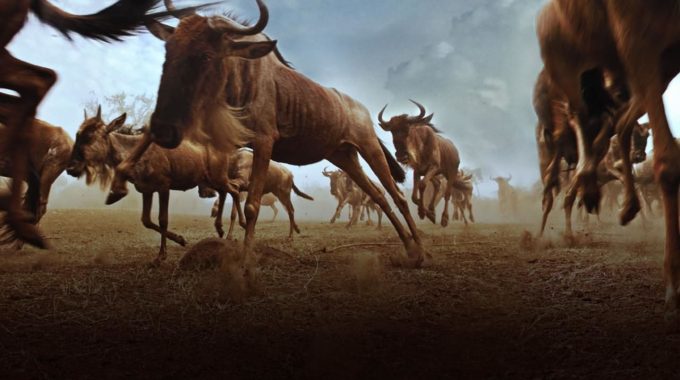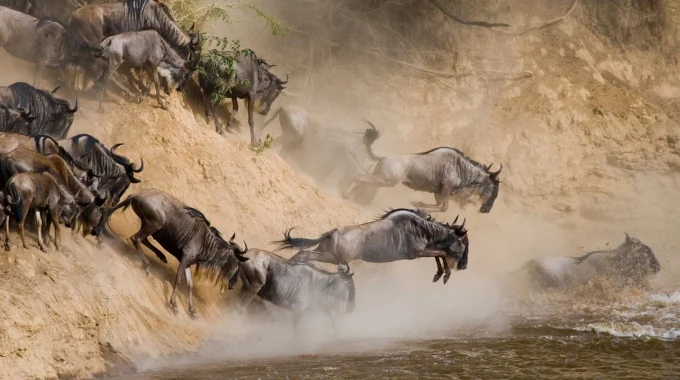Zanzibar, an exotic island paradise in the Indian Ocean, is a dream destination for many…
How many wildebeests travel together?
How many wildebeests travel together? – Wildebeests are known for their impressive migrations, and they typically travel in large groups called herds. These herds can vary in size depending on the time of year, food availability, and environmental factors. Here’s a detailed look at how wildebeests travel together:

1. Migration Herds
- Migration Scale: Wildebeests are most famous for their annual migration in East Africa, particularly in the Serengeti (Tanzania) and Maasai Mara (Kenya). During the migration, wildebeests travel together in massive herds that can number from several thousand to over a million animals. The herd size can fluctuate based on the time of year and the specific stage of the migration.
- Largest Herds: Some of the largest herds can consist of 500,000 to 1.5 million wildebeests. The animals’ quest for food and water is what causes the migration, one of the most amazing wildlife phenomena on Earth. Along with wildebeests, the herds often include zebras, gazelles, and other grazers, which travel together for safety and resources.
2. Herd Structure
- Leadership and Organization: Within these vast herds, wildebeests tend to travel in loose groups based on age and sex. Males, females, and calves may form their own subgroups. There is no single leader, but dominant males may guide smaller groups. The availability of grazing land and water sources generally determines the herd’s movement.
- Movement Patterns: Wildebeests follow well-established migration routes that they have used for generations. Seasonal rains and the resulting green grass often determine these routes. During the migration, wildebeests move in a coordinated manner, often moving together in long lines or tight clusters, particularly when crossing dangerous areas like rivers or when facing predators.
3. Daily Movements
- Continuous Movement: Wildebeests don’t stay in one place for long. During the migration, they move continuously in search of food and water. The herd moves slowly, grazing as they go, and they can cover up to 10-30 kilometers (6-19 miles) a day, depending on the terrain and available resources.
- Resting and Grazing: While wildebeests are known for their long-distance movement, they do stop to rest and graze. At night, they typically rest in the safety of the herd. During the day, they are mostly foraging, staying alert for predators.
4. Predator Avoidance
- Safety in Numbers: Traveling in such large herds provides some level of protection against predators. Predators like lions, hyenas, and crocodiles are a constant threat, especially during river crossings, but the sheer number of wildebeests reduces the chances of any individual being singled out. The herd will often create confusion and chaos, making it harder for predators to target a specific animal.
- Vigilance: Within the herd, wildebeests stay vigilant for danger. They often travel together in tight formations, and when a threat is perceived, the herd will usually move together in unison, either running away or freezing in place to confuse predators.
5. Social Behavior
- Communication: Wildebeests communicate with each other through vocalizations such as snorts and grunts. They also use body language to signal distress or danger. This social communication is key to maintaining herd cohesion, especially when crossing dangerous terrain.
- Calf Protection: Mothers and calves often form close bonds, and calves are kept at the center of the herd to provide extra protection. During the calving season (usually just before the migration), wildebeests give birth in synchrony, with hundreds of calves being born within a short time span.
6. Post-Migration Behavior
- Disbanding the Herds: After the migration, the wildebeests may disband into smaller groups once they return to their usual grazing areas, usually around the Serengeti and Maasai Mara regions. Here, they will begin the cycle again: calving, grazing, and preparing for the next migration season.
In summary, wildebeests travel in incredibly large herds, often numbering in the hundreds of thousands to millions, during their migration. These herds provide safety from predators and are a critical part of their survival strategy. The herds are dynamic, with shifting structures and communication that ensure the group can move efficiently and respond to dangers.



